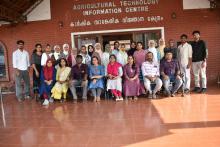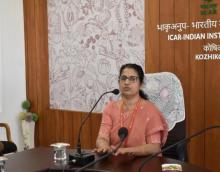Cardamom thrips (Sciothrips cardamomi) is a major insect pest of cardamom(Elettaria cardamomum) causing severe economic losses to the crop in all cardamom producing countries. The present control measures rely heavily on chemical insecticides,which in addition to increased input costs also lead to pesticide residues in the produce and environmental hazards. Although the crop is of high commercialvalue, limited efforts have been made to identify sources of resistance to this major pest. Exploiting sources of resistance along with integrated pest management tactics will help to reduce pesticide usage in this crop promoting sustainable production.The present study aimed at identifying sources of resistance against cardamom thrips and the associated plant morphological traits conferring resistance against the pest. Field screening of 180 cardamom germplasm accessions for 3 years at Appangala, Karnataka, India, resulted in identification of eight accessions resistant to cardamom thrips. Differences in panicle type and the nature of adherence of leaf sheath to the pseudostem explained a significant amount of the variance in resistance and therefore are likely to play a major role in conferring resistance against this pest.Field screening of 180 cardamom germplasm accessions for 3 years at Appangala, Karnataka, India, resulted in identification of eight accessions resistant to cardamom thrips. Differences in panicle type and the nature of adherence of leaf sheath to the pseudostem explained a significant amount of the variance in resistance and therefore are likely to play a major role in conferring resistance against this pest. Multiple regression analysis of the different traits indicated that accessions with prostrate panicles having leaf sheath loosely adhered to the pseudostems were found to have significantly less thrips damage, when compared with other panicle and leaf sheath types. However, persistence of flower bract did not have a significant additive effect on imparting resistance against thrips. Metabolomic analysis of the accessions may provide further insight into the existence of supplementary biochemical mechanisms, if any, in imparting resistance. The identified traits and accessions can be exploited in future breeding programmes
for developing thrips resistant cardamom varieties.
for developing thrips resistant cardamom varieties.













